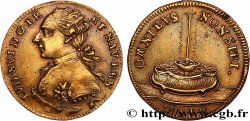Obverse
Obverse legend : LUD. XVI. D. G. FR. ET. NAV. R.
Obverse description : Portrait de Louis XVI à droite, en habits brodés et cheveux attachés.
Reverse
Reverse legend : RECH. PFENN. À L’EXERGUE: E.L.S.L..
Reverse description : Diane allant à droite, tenant son lévrier en laisse. Devant elle, trois arbres.
Historical background
LOUIS XVI
(05/10/1774-01/21/1793)
After the days of October 5 and 6, 1789, the Parisians brought back from Versailles to Paris, "the baker, the baker and the little baker" (royal family) who settled in the Tuileries. On November 2, 1789, the property of the Church was nationalized. The kingdom is divided into 83 departments in December. On April 17, 1790, the assignat became paper money and became legal tender, then forced tender from September. The property of the clergy is put up for sale as "national property". On June 19, titles and nobility are abolished. On July 12, the Civil Constitution of the Clergy is voted. The Federation Day, July 14, seems to mark the end of the Revolution and symbolizes what unites the King, the kingdom and the people. Mirabeau died on April 12, 1791. The passage of the Le Chapelier law prohibited corporations, associations and professional unions and suppressed the right to strike. The King was arrested in Varennes on June 22 while trying to escape. La Fayette had the crowd fired at the Champ de Mars on July 17, 1791. On September 3, the Legislative Assembly replaced the Constituent Assembly, which separated. The King takes an oath to the Nation.










 Report a mistake
Report a mistake Print the page
Print the page Share my selection
Share my selection Ask a question
Ask a question Consign / sell
Consign / sell
 Full data
Full data















